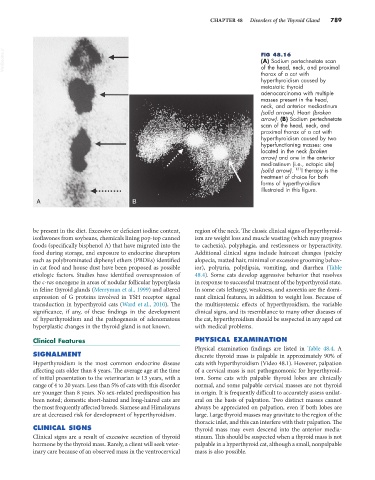Page 817 - Small Animal Internal Medicine, 6th Edition
P. 817
CHAPTER 48 Disorders of the Thyroid Gland 789
VetBooks.ir FIG 48.16
(A) Sodium pertechnetate scan
of the head, neck, and proximal
thorax of a cat with
hyperthyroidism caused by
metastatic thyroid
adenocarcinoma with multiple
masses present in the head,
neck, and anterior mediastinum
(solid arrows). Heart (broken
arrow). (B) Sodium pertechnetate
scan of the head, neck, and
proximal thorax of a cat with
hyperthyroidism caused by two
hyperfunctioning masses: one
located in the neck (broken
arrow) and one in the anterior
mediastinum (i.e., ectopic site)
(solid arrow). 131 I therapy is the
treatment of choice for both
forms of hyperthyroidism
illustrated in this figure.
A B
be present in the diet. Excessive or deficient iodine content, region of the neck. The classic clinical signs of hyperthyroid-
isoflavones from soybeans, chemicals lining pop-top canned ism are weight loss and muscle wasting (which may progress
foods (specifically bisphenol A) that have migrated into the to cachexia), polyphagia, and restlessness or hyperactivity.
food during storage, and exposure to endocrine disruptors Additional clinical signs include haircoat changes (patchy
such as polybrominated diphenyl ethers (PBDEs) identified alopecia, matted hair, minimal or excessive grooming behav-
in cat food and house dust have been proposed as possible ior), polyuria, polydipsia, vomiting, and diarrhea (Table
etiologic factors. Studies have identified overexpression of 48.4). Some cats develop aggressive behavior that resolves
the c-ras oncogene in areas of nodular follicular hyperplasia in response to successful treatment of the hyperthyroid state.
in feline thyroid glands (Merryman et al., 1999) and altered In some cats lethargy, weakness, and anorexia are the domi-
expression of G proteins involved in TSH receptor signal nant clinical features, in addition to weight loss. Because of
transduction in hyperthyroid cats (Ward et al., 2010). The the multisystemic effects of hyperthyroidism, the variable
significance, if any, of these findings in the development clinical signs, and its resemblance to many other diseases of
of hyperthyroidism and the pathogenesis of adenomatous the cat, hyperthyroidism should be suspected in any aged cat
hyperplastic changes in the thyroid gland is not known. with medical problems.
Clinical Features PHYSICAL EXAMINATION
Physical examination findings are listed in Table 48.4. A
SIGNALMENT discrete thyroid mass is palpable in approximately 90% of
Hyperthyroidism is the most common endocrine disease cats with hyperthyroidism (Video 48.1). However, palpation
affecting cats older than 8 years. The average age at the time of a cervical mass is not pathognomonic for hyperthyroid-
of initial presentation to the veterinarian is 13 years, with a ism. Some cats with palpable thyroid lobes are clinically
range of 4 to 20 years. Less than 5% of cats with this disorder normal, and some palpable cervical masses are not thyroid
are younger than 8 years. No sex-related predisposition has in origin. It is frequently difficult to accurately assess unilat-
been noted; domestic short-haired and long-haired cats are eral on the basis of palpation. Two distinct masses cannot
the most frequently affected breeds. Siamese and Himalayans always be appreciated on palpation, even if both lobes are
are at decreased risk for development of hyperthyroidism. large. Large thyroid masses may gravitate to the region of the
thoracic inlet, and this can interfere with their palpation. The
CLINICAL SIGNS thyroid mass may even descend into the anterior media-
Clinical signs are a result of excessive secretion of thyroid stinum. This should be suspected when a thyroid mass is not
hormone by the thyroid mass. Rarely, a client will seek veter- palpable in a hyperthyroid cat, although a small, nonpalpable
inary care because of an observed mass in the ventrocervical mass is also possible.

